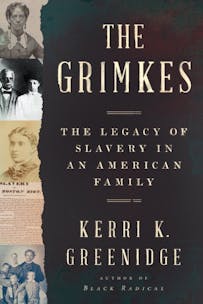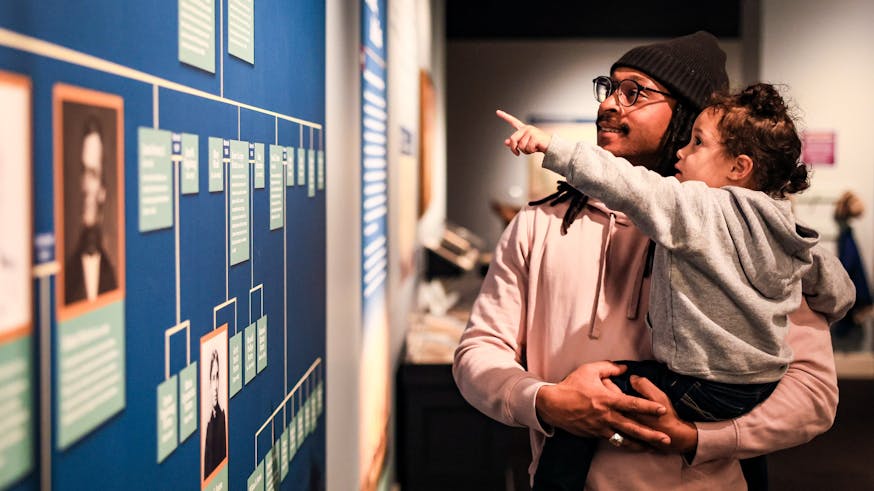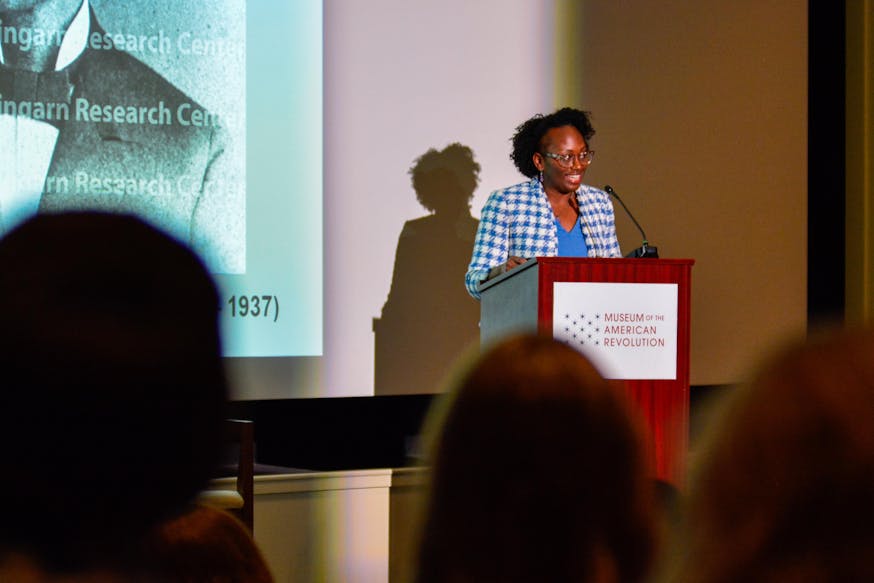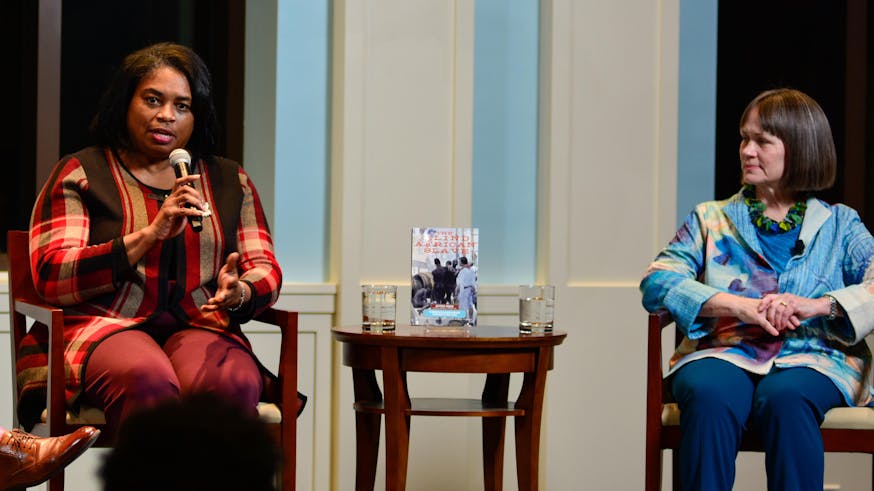Read the Revolution
The Grimkes
March 22, 2023
Purchase the book from W.W. Norton & Company.
Editors Note: Greenidge does not use the accent mark in Grimké, thus we followed that style in this edition.
In Dr. Kerri K. Greenidge’s award-winning new book, The Grimkes: The Legacy of Slavery in an American Family, the story of one multiracial family underscores that “the pursuit of knowledge — the ability to think, analyze, and conceptualize beyond basic literacy — was as important to Black founders as freedom itself.” Where did this learning take place, and how did Black and white women organize these educational and reform efforts in Philadelphia?
Greenidge reclaims the forgotten Black Grimke family members, especially Charlotte Forten Grimke and Angelina Weld Grimke, as complex individuals shadowed by their white Quaker abolitionist aunts, Sarah and Angelina Grimke. Although the more famous Grimke sisters joined members of the Forten and Douglass families in The Philadelphia Female Anti-Slavery Society and fought for the end of slavery, Greenidge argues that “they could not imagine Black equality.” The compelling cast of characters in the Forten, Grimke, and Douglass families presented in The Grimkes underscores the long struggle for racial and gender equality.
In this excerpt from Part I: Forgetting How to Weep, 1790-1840, Greenidge illustrates the activities at 92 Lombard Street, where James and Charlotte Forten lived and officially opened a private school for Black children in 1819 with Sarah and Robert Douglass. The eldest Forten daughters — Margaretta, Charlotte, and Harriet — befriended twins Sarah and Elizabeth Douglass. Sarah Douglass became a primary teacher at the school in 1826. These sisters grew up together and met other reform-minded Black and white women, including the white Grimke sisters, Mary Wood (future wife of Robert Bridges Forten and the mother of educator Charlotte L. Forten), Lucretia Mott, and Harriet Forten Purvis, at The Philadelphia Female Anti-Slavery Society, formed in 1833. Greenidge explains that the Society “quickly became a powerful vehicle for women’s political participation, devoting itself to antislavery petitions, congressional appeals, and public lectures designed to bring women into the growing abolitionist movement.”
Excerpt
Whether they stayed at 92 Lombard Street overnight or boarded over a period of years, this constant stream of visitors tightened the Fortens’ ties to Black political leaders up and down the Atlantic coast. Regulars included Freedom’s Journal editors John B. Russwurm and Samuel Cornish – whose monthly founded in 1827 was the first Black-owned and -operated newspaper in the United States—and other renowned Black abolitionists and church founders like Boston educator Prince Saunders, Baptist minister Thomas Paul, Charleston minister Daniel Payne, and Pittsburgh editor Martin R. Delany. For over half a century, Charlotte [Vandine Forten] Sr. presided over a welcoming hearth that nurtured the foundational Black politics upon which white antislavery orators like the Grimke sisters would rely.
A founding tenet of this emerging Black movement was abolition, a radical politics of immediate emancipation long championed by Black ministers and community leaders but first articulated by white reformers in words spoken by Pennsylvania Abolition Society (PAS) founder Benjamin Rush [....] Free Black people had a responsibility to lift up the less fortunate among them. And Black leaders like James Forten – not well-meaning, paternalistic reformers in the PAS—should lead the race to its rightful place within the nation.
With their substantial wealth and large family, Charlotte Sr. and James Forten formed an axis around which a network of similarly community-minded Black founders revolved, providing personal and financial support for Black communities up and down the northern Atlantic seaboard. But as Charlotte Sr. gave birth to and raised eight children in the warm comfort of Black community building and abolitionist discourse, the limitations placed on Black possibility in a rapidly expanding slaveholding republic strengthened her ties to Black women like herself who demanded for their children all that Southern slavery and gradual emancipation would deny.
[...]
However Mary [Wood] and the Fortens met, by January 1834, as the founders of the PFASS elected officers and drafted a constitution in the meeting hall of the Second Presbyterian Church on Cherry Street. Mary Wood was close enough to the Forten sisters and their childhood friend Sarah Mapps Douglass to sign her name alongside theirs to various abolitionist petitions and congressional resolutions submitted by PFASS as part of their ambitious plan. Their goal was to force immediate emancipation across the country by spreading the word that “slavery and the prejudice against color are contrary to the laws of God.” At PFASS meetings, which met every other week to “collect and disseminate correct information of the character of slavery” and to “dispel the prejudice against the people of color,” Mary Wood, the Fortens, and Sarah Douglass were often the only Black women in a sea of well-intentioned, if self-righteous, white Quakers. And so the women became close. The Forten sisters held a special tea in Mary’s honor to introduce her to the Philadelphia Female Literary Association; they invited her to Bible study at St. Thomas’s Church; and they urged her to sign the most coveted social contract of Black Victorian womanhood – the friendship album.
But most important for Mary, the Forten and Douglass women introduced her to a radical abolition movement that her mother, Edith, shunned. After the horrors of the 1834 riots, Edith had retreated to her rented home in Spring Garden with her three youngest daughters while Mary threw herself into the world of PFASS meetings and abolitionist lectures that flower through Black life at 92 Lombard. Mary saw how Black women used a predominantly white organization like the PFASS to bring much-needed support to their community, a lesson in Black institution-building that was wholly independent of supposed white allies who often failed to fully listen to the very people they aimed to help.
[...]
Mary [Wood] was in the room when Margaretta Forten and Sarah Douglass insisted that the white women in the Key’s Alley schoolhouse include “improvement of the condition” of colored people in the society’s list of resolutions. After teaching for a time at the African School in New York City, both Margaretta and Sarah believed that Philadelphia could transform the educational model born from the school at 92 Lombard Street into a standard for Black schoolhouses across the city. Sarah, in particular, wanted the PFASS to make good on its promise to “improve the condition” of free Black people by funding the school’s expansion. The wooden stools and bookshelves in the Forten family attic and parlor may have been sufficient when only their family and kin attended, but if Sarah and Margaretta wanted to maintain the high standards of subject learning and grade instruction started by Britton Chamberlain, they needed a real schoolhouse with salaried teachers and enough slate stone to go around. By 1836, due at least in part to the Black women’s demands, the PFASS appropriated money and larger facilities for what was rapidly becoming the most respected Black private school in the country.
While Mary watched Margaretta and Sarah negotiate the terms under which Black women supported the PFASS, she also saw how Harriet Forten used her marriage to Robert Purvis to connect the PFASS to Black men's goals in the American Anti-Slavery Society. Purvis was the second of three sons born in Charleston to the cotton broker William Purvis and an enslaved woman named Harriet Judah. The wealth that Robert and his brothers inherited after their father's 1827 death catapulted the Purvises to a level of economic security that even James Forten's lifelong financial success couldn't match. And when Harriet Forten married Robert in 1831, the two quickly became leading figures among the region's Black elite. A founder of both the Colored Convention Movement and the American Anti-Slavery Society, the brown-haired, green-eyed Purvis was known for his fierce racial pride in the face of white men who accused him of "amalgamation" when they saw him walking hand in hand with his darker-skinned wife. These same white men then raged violently when they discovered that Purvis was Black. As a founding member of the PFASS, Harriet Forten Purvis used her husband's work in the Colored Free Produce Association to strengthen the society's ties to free Black farmers and vegetable sellers. She also helped the society create a "standing committee" to visit and document the deplorable conditions of the city's two Black schools.
[...]
Sign Up
Get biweekly Read the Revolution featured excerpts right to your inbox.
Out of all of the Forten sisters, however, the youngest, Sarah, was the one to whom Mary Wood was most drawn, partly because they were close in age but also because Sarah was a popular poet and artist. She was just sixteen when her most famous poem, "The Slave Girl's Address to Her Mother," appeared in the Liberator. "Oh! Ye who boast of Freedom's sacred claims, / Do ye not blush to see our galling chains"—Sarah’s dramatic ode to Black motherhood became so popular in antislavery circles that the Black musician Frank Johnson adapted it to music so that it could be performed in song at abolitionist fundraisers across the North. Known for her natural charisma, as well as her sophisticated grasp of classical political economy, Sarah caught the attention of abolitionists George Thompson and John Greenleaf Whittier. The two white men often recalled discussing English common law with the teenaged Sarah one spring evening in the front parlor of 92 Lombard Street. The scene was so memorable to Whittier that he wrote his poem "The Sisters Forten" at least in part as an ode to Sarah's singular charm. Perhaps in Sarah-the free, refined, and dignified daughter of the most successful Black businessman in Philadelphia— Mary Wood saw the finest example of how bold Black women her own age could shape predominantly white antislavery societies' relationship to free Black communities.
[...]
Over the next two decades, the Fortens and the Purvises offered support to various PFASS subscription drives and fugitive slave rescues, but they would never let white women control the terms under which they demanded Black liberation.
Mary Wood left the PFASS in the late 1830s, by which time her relationship to the Forten family had deepened through her courtship and marriage to Robert Bridges, the Forten family’s second oldest son and the most gifted of the Forten siblings [...] When Mary Wood joined the inaugural session of the PFASS on Key’s Alley, Robert was the co-owner and manager of his father’s Forten and Sons Sail Loft and a committed abolitionist who made his speaking debut before the PFASS in November 1834.
[...]
Perhaps it was during one of these PFASS lectures that Sarah and Angelina [Grimke] first interacted with Black women like the Douglasses, the Fortens, and Mary Wood, women who ran committees, offered their opinions, and interacted with white women beyond the role of the “supplicant slave" with which the Grimke sisters were so familiar. Perhaps Sarah and Angelina were humbled while watching Sarah and Grace Douglass organize petition drives and demand funding for colored schools. In Charleston, after all, Black women cooked, cleaned, and fulfilled every white demand, their own desires and needs inconsequential to white people like the Grimkes. Of course, after living in Philadelphia for nearly fifteen years, Sarah Grimke was not completely unaware of Black women as active agents in their own communities. Indeed, Sarah and Grace Douglass were two of only a handful of Black members at Arch Street Meeting, where their regal dark skin in a sea of whiteness could not have been easily ignored. But until Sarah and Angelina saw the Douglasses managing PFASS committee meetings, the white women neither acknowledged the Black women's existence nor challenged their segregation in the "negro pew." Now, for the first time in their lives, the Grimke sisters were forced to interact with unbending, unapologetic Black women as equals, and as they listened and learned, they felt compelled to reach out.
Kerri K. Greenidge, The Grimkes: The Legacy of Slavery in an American Family (W.W. Norton, 2022), 43-44, 57-64.
Tags
Learn More

Black Founders: The Forten Family of Philadelphia
February 11 - November 26, 2023
AmRev Presents: Dr. Kerri Greenidge, Author of The Grimkes

